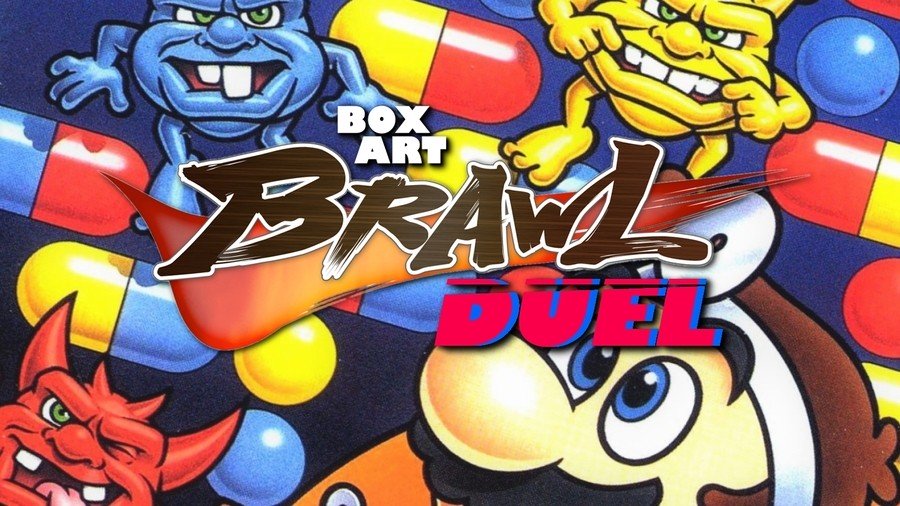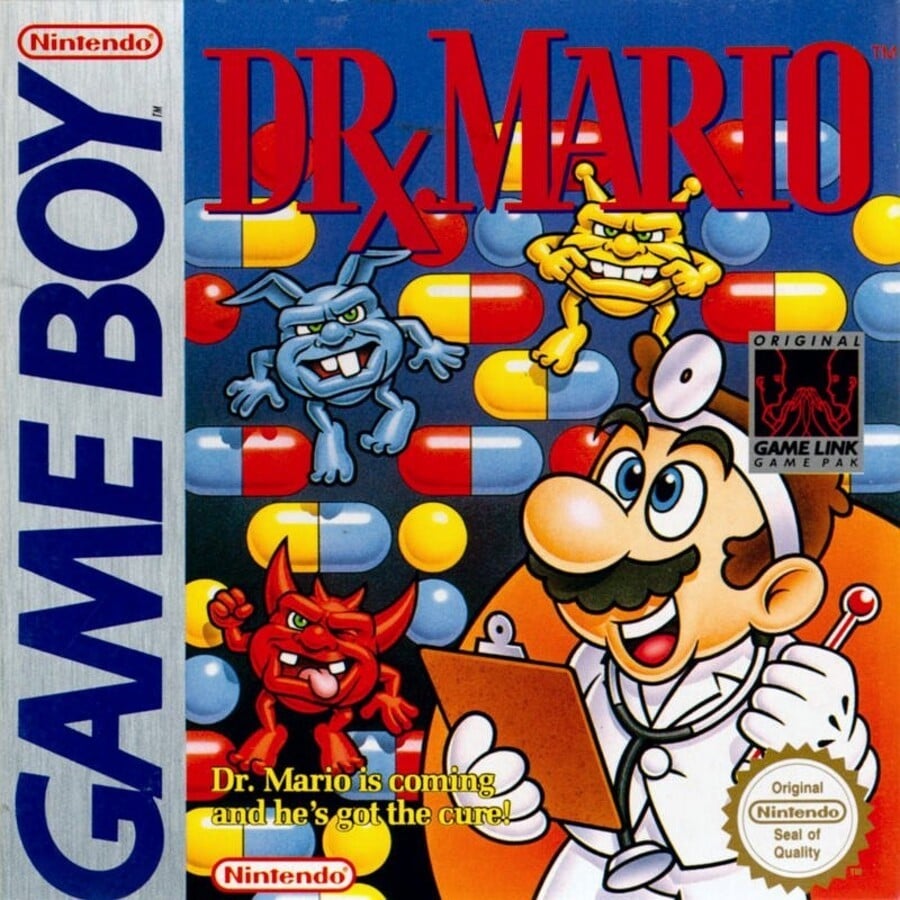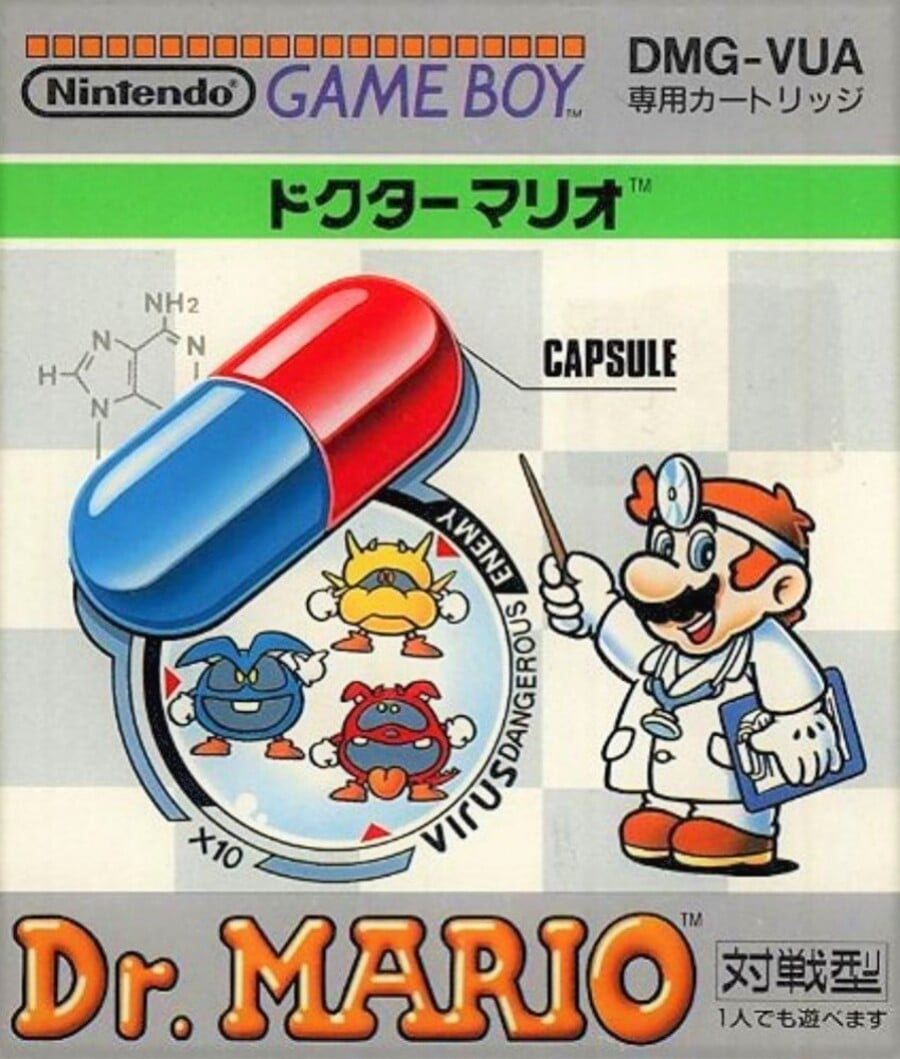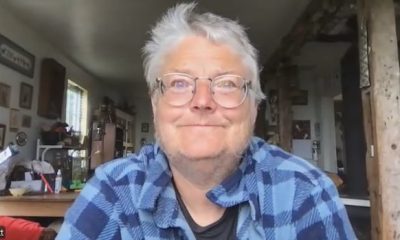
Kazuyuki Takezaki, Board / Table, 2023.
Courtesy Misako & Rosen, Tokyo, and 47 Canal, New York

Welcome to Box Art Brawl, our weekly bout to find out which regional box art variant is the best, according to you lovely lot.
Last week was the inaugural edition of the ‘Duel’ variant of Box Art Brawl, which saw two versions of Tetris for the Game Boy square off against each other. Despite a rather fetching entry from the East, it was the version that released in North America and Europe which won over 80% of your hearts.
This week we’re sticking with the Game Boy as the ‘Jack-of-all-trades’ plumber tries his healing hands at medicine in Dr. Mario, the puzzler that launched for both Game Boy and NES 30 years ago last week. It’s an unusual game that released across both home and handheld consoles, with box art that looked more-or-less the same on both. We’ve gone with the Game Boy just to keep things more compact.
If you’re after more info on the game, we recommend checking out Jeremy Parish’s excellent Game Boy Works video on the subject. In the meantime, the (alleged) doctor is in. He’ll see you now…

Featuring a red logo with a serif font and the stylised prescription symbol ‘℞’, the version we got in the West shows a wall of capsules in the background as a trio of primary-coloured gribblies lark around. Mario stands in the foreground on the right against a circular orange something brandishing a clipboard, a thermometer and a big grin. In fact, he appears to be doing his finest Dr. Nick Riviera impression.
It’s colourful, the enemies look mischievous and fun, and–assuming you’ve got the same infantile sense of humour we do–it’s got a winning tagline laden with eyebrow-raising double entendre. A strong opener, although it’s arguably a bit busy, especially when viewed from a distance.

The Japanese version takes a more scientific approach, with ‘Doctor’ Mario looking far more scholarly and knowledgeable. The oversized capsule he’s pointing to is flanked by a diagram of the enemy virus as he lectures us on the subject. The subtle chemical formula in the top left adds extra weight to his medical credentials, to the point where you’d be forgiven for allowing the jovial plumber to perform complex surgery on you. Come on! He’s pointing at the red end of a capsule that he’s labelled ‘CAPSULE’ – of course he’s qualified!
The logo font still has serifs, although the bubble style doesn’t scream ‘professional medical practitioner’. Still, we like this a lot.
So, which doctor would you permit to examine you? Pick your favourite from the two options below and click ‘Vote’ to let us know:
That’s it for this week – Happy Birthday Dr. Mario! Which did you go for? Let us know below, and join us again next week for another edition of the Box Art-iest of Brawls.

An exterior nighttime rendering shows the Arts Commons Transformation expansion’s curved form, exterior cladding, and interior finishes inspired by Alberta’s dramatic landscapes and the regional lodge typologies.Supplied
Downtown Calgary urgently needs new energy, and the city’s performing-arts centre is ready to give the city a jolt.
This week’s announcement of a historic $75-million donation from local oil executive Dave Werklund and family lets Arts Commons advance its transformation into a “campus” of two buildings linked by lively public space, a zone in which the arts are part of a larger stew of activity.
In this, Arts Commons creates an important lesson for other cities: Great urbanism can’t happen with just one building, and an urban institution must always look at what’s happening outside its walls.
Since the project was announced in 2022, it’s become larger: The arts institution took control of the adjacent Olympic Plaza, a square built for the 1988 Winter Games, and it will integrate it fully into the design and operation of the institution. The square redesign, which is in progress, is by the first-rate team of Montreal landscape architects CCXA and Toronto architects GH3 with consultants Belleville Placemaking.
Arts Commons president and chief executive officer Alex Sarian, in an interview this week, sounded most excited about the landscape portion of the project. “To have a massive outdoor space as our front door changes everything,” he said. “The plaza becomes a hub for cultural activity, free family programming and just hanging out.”
This is not normal behaviour for an arts CEO, especially one who’s about to break ground on a new showpiece building. That building, the centre of the Commons redevelopment, is a three-storey structure with a highly flexible 1,000-seat theatre and 200-seat studio theatre plus a wealth of public gathering space, all of them with doors at street level to maximize accessibility and permeability.
A rendering of Arts Commons’ new 1,000-seat theatre, set up for a rock concert. The new performance space will help meet the Calgary’s burgeoning demand for arts and culture venues.Supplied
The building’s design, created collaboratively by Toronto’s KPMB Architects, Calgary’s Hindle Architects and Tawaw Architecture Collective, is instantly memorable. Its southeast corner addresses the adjacent Olympic Plaza with a large publicly accessible space with a café – not a lobby, but a “lodge,” as the designers frame it. Here, a curved facade of slatted wood leans back as it rises. Framed with chunky columns of mass timber, the structure resembles something shaped by human hands, a lantern or a basket or perhaps a wigwam.
According to the architects, this came out of an effort to overcome Calgarians’ feelings that theatre is an elite activity. “We had a long discussion of how a theatre building could feel entirely welcoming and warm,” said KPMB partner Kevin Bridgman.
It also drew on Indigenous traditions, particularly the cross-cultural idea of a lodge, a collective gathering place. “The lodge is a very Indigenous concept, and it exists from east to west,” Wanda Dalla Costa of Tawaw added. “From the shed house on the West Coast to the wigwam on the East Coast and the tipi in the middle, these forms are all quite complex, but they share a ruggedness in their shapes that we wanted to evoke here.”
(The lodge also strongly recalls the unbuilt 2020 design for the Art Gallery of Nova Scotia, which KPMB designed with a team including architect Omar Gandhi and Mi’kmaq artist Jordan Bennett. Ideas have a way of coming back around.)
The lodge space is punctuated by a green spiral stair and a wall of ceramic decoration patterned after decorative artwork made by local Indigenous people. Colour; ornament; texture. These are qualities that most people like, but architects often don’t. Here, they look fantastic.
The design promises to deliver on its social goals. Sarian identifies these as engaging locals with all sorts of cultural activity including robust education programs and “just to bring them in.” The emphasis on the square, and on varied informal activity, is crucial here. Most 20th-century performing-arts complexes are opaque and aloof – including the Arts Commons’ original six-theatre building, from 1985, which will be renovated later by the same design team. Such complexes “seem dead 80 per cent of the time when a performance isn’t going on,” Sarian said. “That’s not a good way to build a city. We will do things very differently.”
On their success will hinge a larger economic goal: bringing people into the downtown, which has historically been very heavy on office space and which was walloped by oil price shocks and then the COVID-19 pandemic. In 2021, office vacancies neared 30 per cent.
“Calgary’s downtown has historically not been a place where people linger, especially after 5 p.m.,” said Kate Thompson, president and CEO of the city’s Calgary Municipal Land Corp. “This campus is a place people come after five, so we’re trying to amplify that. You can’t revitalize a downtown without giving people a reason to come downtown. I think this is going to be a strong reason for people to come downtown.”
That is a lot to ask of an arts centre, and Thompson emphasized that the city has many other initiatives under way to make downtown a 24-hour place.
But even one building can make a difference in changing the atmosphere. Calgary has already seen this with its 2018 Central Library, a block away from Arts Commons. “That building was the first step toward a downtown architecture that’s welcome, and provides spaces for people to connect,” said Calgary-based Jordan Hindle of Hindle Architect. “It changed the conversation.”
The Arts Commons revitalization, he added, will advance the library’s project of civic space, “spaces that are inviting to everyone, where people will connect.”
There is strong reason to believe this will work. While the downtown has huge challenges – lots of big roads and, still, many empty buildings – Calgary is young and fast-growing. Things can change. More than a dozen office-to-apartment conversions, two of them within a block of Arts Commons, will bring new residents. And, crucially, Calgary’s city government cares about design. The city’s leadership, including Thompson, understands that beautiful places for collective experiences have value. They are some of the most valuable assets a big city has to offer, and they may even be enough to turn a city around.

Kazuyuki Takezaki, a painter whose blurry, washed-out landscapes made him a closely watched artist of Japan’s art scene, has died at 48 after a heart attack. Jeffrey Rosen, cofounder of Takezaki’s Tokyo-based representative Misako & Rosen, confirmed the artist’s death and said his gallery was working to establish an estate for Takezaki.
Takezaki died just weeks after the closure of his first major New York solo exhibition, at 47 Canal gallery. That show featured recent paintings of trees, mountains, greenery, and more that he spotted in Marugame, the seaside city in Japan where he was based.
These paintings, with their forms that melt into abstraction, attest to a natural world that is slipping away, given that manmade industrial interventions now pose a significant threat to the area around Marugame. “Communicating a profound yet fleeting sense of place, Takezaki’s windows onto this constantly shifting environment are also reflections on time, memory, and the porous overlaps between subject and object,” Andrew Maerkle wrote in an essay accompanying the 47 Canal show.
The 47 Canal show was one of the few exhibitions Takezaki had held in the US. In Japan, he had built a significant resume, with solo shows held at the Kochi Museum of Art and Misako & Rosen.
He was born in Kochi, Japan, in 1976, and his birthplace would continue to loom large over his practice. “Such a combination, that of the natural and artificial within this town so full of possibility and prompts my imagination,” he wrote in an exhibition text for a 2008 Misako & Rosen exhibition.
Takezaki went on to attend Kochi University. Then, upon graduation in 1999, he relocated to Tokyo, where he focused on building out his artistic practice.
Early on, Takezaki’s art appeared in group shows held by blue-chip galleries, such as New York’s Yvon Lambert and Tokyo’s Ota Fine Arts. But it was a gallery of Takezaki’s making that helped earn his place in the Japanese scene: Takefloor, which he launched within his small Tokyo apartment.

Kazuyuki Takezaki, Board / Table, 2023.
Courtesy Misako & Rosen, Tokyo, and 47 Canal, New York
Jeffrey Rosen, Takezaki’s dealer, credited Takefloor with acting as a catalyst for experimental art in the Japanese art scene. Rosen credited Takefloor with inspiring him to open Misako & Rosen, telling Artspace in 2015 that Takezaki’s gallery “gave everybody of our generation the courage to start opening up our own space.”
After working in Tokyo for a period, Takezaki returned to Kochi, then moved to Marugame. In the latter city, he began making his “Board / Table” paintings, for which he would attach a canvas to a board, then drive beyond the city with it. In view of mountains and trees, he would depict what he saw in oil stick, working quickly in an attempt to make permanent all this nature in flux over the course of several days. Some of these works appeared this year at 47 Canal and in 2023 at Milwaukee’s Green Art Gallery, in his first US solo show.
Though they started out figural, these pieces quickly dissolved into blobs of muted color. “At dusk,” Takezaki once remarked, “I often see the town horizontally divided into upper and lower halves by transparent and opaque color.”
A case investigators have called Canada’s largest art fraud investigation has revealed one of thousands of paintings falsely attributed to renowned Anishinaabe artist Norval Morrisseau was once on display in Winnipeg’s biggest art gallery.
The fake artwork, called Astral Plain Scouts, was donated to the Winnipeg Art Gallery-Qaumajuq in 2000 by a private collector who got it from a gallery in Thunder Bay, Ont., said Stephen Borys, the Winnipeg gallery’s director and CEO.
The piece was last shown at the gallery in 2013 and is now in storage, after police notified the gallery on Friday it was confirmed to be a fraud following a years-long investigation.
“It’s extraordinary that the work that was in question here … was certified by the Canadian Cultural Export Property Review Board. It was certified by all appraisers,” Borys said. “And yet today, as we look at it, we realize it is part of a larger body of works that are fraudulent.”
Morrisseau, who died in 2007 at age 75, was a renowned artist from the Ojibway Bingwi Neyaashi Anishinaabek First Nation in northwestern Ontario. He’s known as the founder of the Woodland school of art, and his work has been exhibited in galleries across Canada.
Earlier this month, the man behind a scheme to create fraudulent Morrisseau pieces pleaded guilty in an Ontario court to his role operating a fraud ring out of Thunder Bay between 1996 and 2019.
David Voss oversaw the creation of forged artworks falsely attributed to Morrisseau, according to an agreed statement of facts read in court. He was among eight people charged with a total of 40 offences last year, following an investigation into the fake paintings.
Jason Rybak, a detective staff sergeant with the Thunder Bay Police Service who worked on the investigation since it began in 2019, described Voss as “the architect of the whole scheme.”

Rybak said investigators on the case were quickly drawn to Astral Plain Scouts — one of the 11 paintings attributed to Morrisseau in the Winnipeg gallery’s collection — in part because of a black dry brush signature on its back, which was a feature found on other fraudulent Morrisseau works.
Investigators also later determined Voss used a “paint-by-numbers” process that involved drawing an outline in pencil, then marking the areas to be coloured in with letter codes corresponding to different colours — a process outlined in the statement of facts read in court.
Police were ultimately able to confirm the paintings from Voss’s operation were fakes through infrared reflectography, Rybak said, which showed the markings underneath the paint.
He said while police have gotten their hands on many of the roughly 1,700 fake Morrisseau paintings Voss was responsible for, they aren’t in a position to seize them all.
That’s in part because they aren’t concerned that owners like WAG-Qaumajuq — which said it offered to turn over the painting — will sell the piece, and because police would have trouble trying to store that many artworks.
Jonathan Sommer, a lawyer specializing in art fraud and the CEO of Morrisseau Art Consulting Inc., which examines work attributed to the artist, said it’s “kind of incredible” the fraud that involved the piece at the Winnipeg gallery got to be as big as it did.
It should also be a lesson for museums and galleries to actively police the authenticity of the works in major collections, he said.
“They can do that in terms of having provisions and agreements with donors. They can do that in terms of upping the amount of effort they make to authenticate artworks that are donated or that they acquire, or even ones that have been sitting in their collections for a long time,” Sommer told host Faith Fundal on CBC Manitoba’s Up to Speed.
“I think this almost has to be an ongoing process that is just part of the acquisition and the collections procedure.”
Sommer said he thinks there are still thousands of fake Morrisseau pieces out there, between fraudulent paintings and unauthorized prints of the artist’s work.
WAG-Qaumajuq director Borys said the art gallery will learn from the incident as it does from every acquisition, and that it plans to continue to co-operate with any further investigation into fraudulent Morrisseau works.
“We do this not just to honour the family and the descendants, but also to contribute to the overall research in Canadian art history at this moment with Indigenous art,” Borys said, adding no concerns have been raised about the gallery’s other Morrisseau works.
“There are many, many victims here, beginning with the artist — the artist’s legacy, his family, the fact that fraudulent activities were going on during his lifetime. This is nothing new. And there are the victims … who collected, supported, exhibited, sold what they thought were rightful works.”
A case investigators have called Canada’s largest art fraud investigation has revealed one of thousands of paintings falsely attributed to renowned Anishinaabe artist Norval Morrisseau was once on display in Winnipeg’s biggest art gallery.
Edmonton Oilers stars McDavid, Draisaitl played through injuries in playoffs: coach


Federal government ends northern cod moratorium in Newfoundland after 32 years


A24 Secures New Investment By Josh Kushner’s Thrive Capital Valuing Company At $3.5 Billion


Little sign of new tick-borne disease on Prince Edward Island — so far


Power back on in western Labrador after wildfires knocked out transmission lines
Shell going ahead with Canadian carbon capture and storage projects


What happened to China’s Chang’e 6 lander on the moon’s far side?
Emil Khachaturian Brings Music For Your Soul To the Leah Posluns Theatre